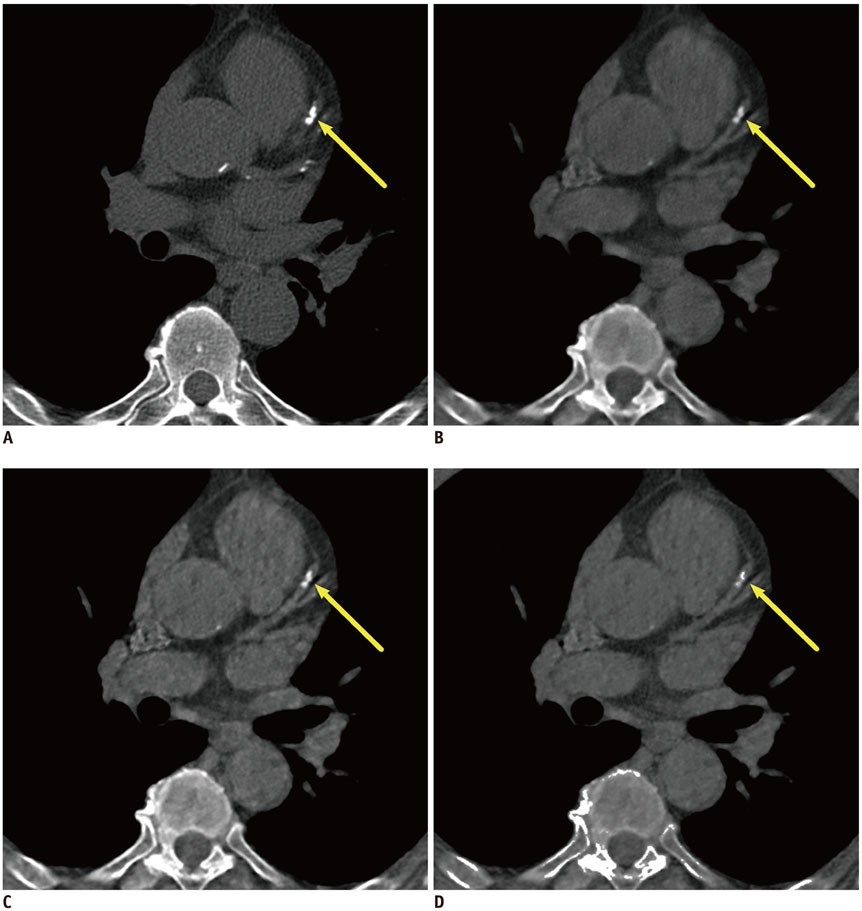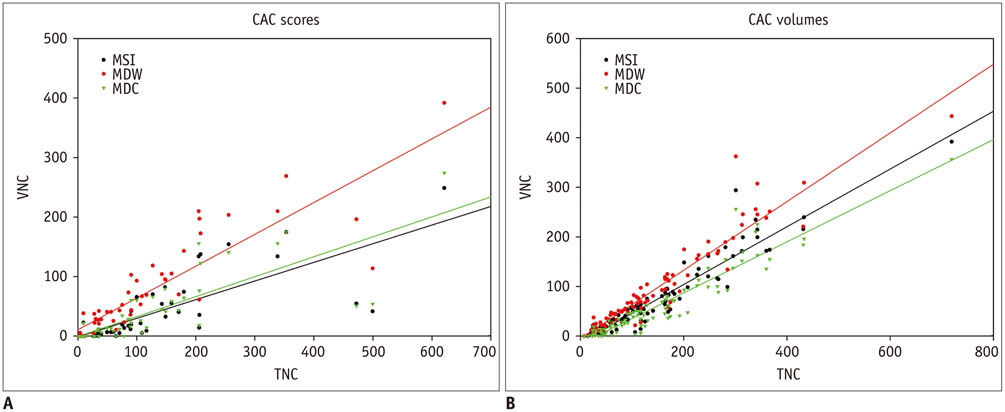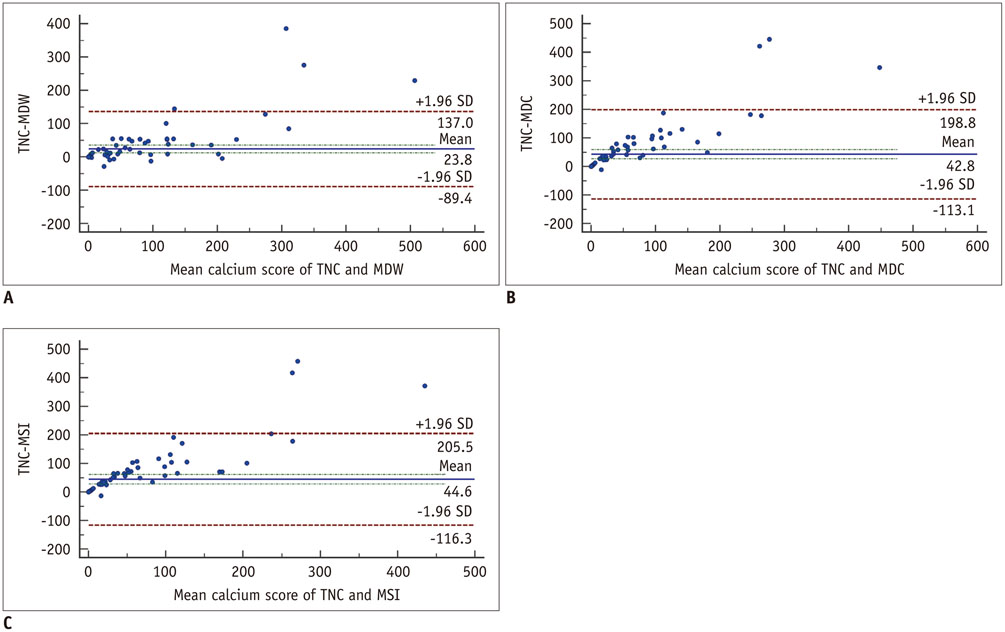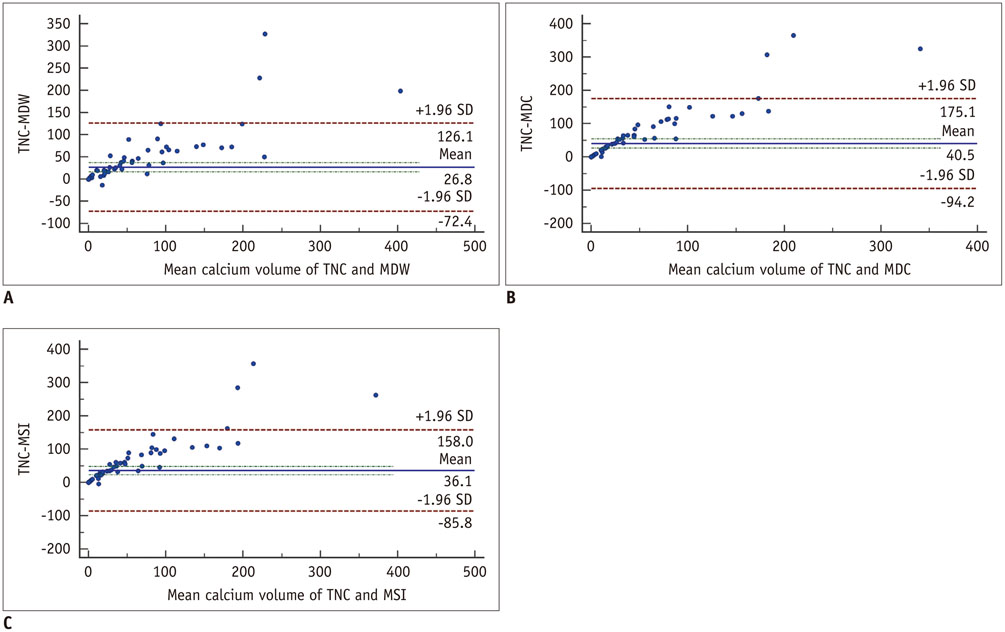Korean J Radiol.
2016 Jun;17(3):321-329. 10.3348/kjr.2016.17.3.321.
Virtual Non-Contrast CT Using Dual-Energy Spectral CT: Feasibility of Coronary Artery Calcium Scoring
- Affiliations
-
- 1Department of Radiology, Konkuk University School of Medicine, Seoul 05030, Korea.
- 2Department of Radiology, Samsung Medical Center, Sungkyunkwan University School of Medicine, Seoul 06351, Korea. mjchung@skku.edu
- 3Department of Digital Health, SAIHST, Sungkyunkwan University, Seoul 06351, Korea.
- KMID: 2451407
- DOI: http://doi.org/10.3348/kjr.2016.17.3.321
Abstract
OBJECTIVE
To evaluate the feasibility of coronary artery calcium scoring based on three virtual noncontrast-enhanced (VNC) images derived from single-source spectral dual-energy CT (DECT) as compared with true noncontrast-enhanced (TNC) images.
MATERIALS AND METHODS
This prospective study was conducted with the approval of our Institutional Review Board. Ninety-seven patients underwent noncontrast CT followed by contrast-enhanced chest CT using single-source spectral DECT. Iodine eliminated VNC images were reconstructed using two kinds of 2-material decomposition algorithms (material density iodine-water pair [MDW], material density iodine-calcium pair [MDC]) and a material suppressed algorithm (material suppressed iodine [MSI]). Two readers independently quantified calcium on VNC and TNC images. The Spearman correlation coefficient test and Bland-Altman method were used for statistical analyses.
RESULTS
Coronary artery calcium scores from all three VNC images showed excellent correlation with those from the TNC images (Spearman's correlation coefficient [Ï] = 0.94, 0.88, and 0.89 for MDW, MDC, and MSI, respectively; p < 0.001 for all pairs). Measured coronary calcium volumes from VNC images also correlated well with those from TNC images (Ï = 0.92, 0.87, and 0.91 for MDW, MDC, and MSI, respectively; p < 0.001 for all pairs). Among the three VNC images, coronary calcium from MDW correlated best with that from TNC. The coronary artery calcium scores and volumes were significantly lower from the VNC images than from the TNC images (p < 0.001 for all pairs).
CONCLUSION
The use of VNC images from contrast-enhanced CT using dual-energy material decomposition/suppression is feasible for coronary calcium scoring. The absolute value from VNC tends to be smaller than that from TNC.
MeSH Terms
-
Aged
Aged, 80 and over
Algorithms
Body Mass Index
Calcium/analysis/*metabolism
Coronary Vessels/*diagnostic imaging
Female
Humans
Image Interpretation, Computer-Assisted
Iodine/analysis/metabolism
Male
Middle Aged
Prospective Studies
Reproducibility of Results
Tomography, X-Ray Computed/instrumentation/*methods
Calcium
Iodine
Figure
Cited by 1 articles
-
Optimal Monochromatic Imaging of Spectral Computed Tomography Potentially Improves the Quality of Hepatic Vascular Imaging
Xiao-Ping Yin, Bu-Lang Gao, Cai-Ying Li, Huan Zhou, Liang Zhao, Ya-Ting Zheng, Yong-Xia Zhao
Korean J Radiol. 2018;19(4):578-584. doi: 10.3348/kjr.2018.19.4.578.
Reference
-
1. Polonsky TS, McClelland RL, Jorgensen NW, Bild DE, Burke GL, Guerci AD, et al. Coronary artery calcium score and risk classification for coronary heart disease prediction. JAMA. 2010; 303:1610–1616.2. Budoff MJ, Shaw LJ, Liu ST, Weinstein SR, Mosler TP, Tseng PH, et al. Long-term prognosis associated with coronary calcification: observations from a registry of 25,253 patients. J Am Coll Cardiol. 2007; 49:1860–1870.3. Greenland P, LaBree L, Azen SP, Doherty TM, Detrano RC. Coronary artery calcium score combined with Framingham score for risk prediction in asymptomatic individuals. JAMA. 2004; 291:210–215.4. Wexler L, Brundage B, Crouse J, Detrano R, Fuster V, Maddahi J, et al. Coronary artery calcification: pathophysiology, epidemiology, imaging methods, and clinical implications. A statement for health professionals from the American Heart Association. Writing Group. Circulation. 1996; 94:1175–1192.5. Greenland P, Bonow RO, Brundage BH, Budoff MJ, Eisenberg MJ, Grundy SM, et al. ACCF/AHA 2007 clinical expert consensus document on coronary artery calcium scoring by computed tomography in global cardiovascular risk assessment and in evaluation of patients with chest pain: a report of the American College of Cardiology Foundation Clinical Expert Consensus Task Force (ACCF/AHA Writing Committee to Update the 2000 Expert Consensus Document on Electron Beam Computed Tomography) developed in collaboration with the Society of Atherosclerosis Imaging and Prevention and the Society of Cardiovascular Computed Tomography. J Am Coll Cardiol. 2007; 49:378–402.6. Mylonas I, Alam M, Amily N, Small G, Chen L, Yam Y, et al. Quantifying coronary artery calcification from a contrast-enhanced cardiac computed tomography angiography study. Eur Heart J Cardiovasc Imaging. 2014; 15:210–215.7. Otton JM, Lønborg JT, Boshell D, Feneley M, Hayen A, Sammel N, et al. A method for coronary artery calcium scoring using contrast-enhanced computed tomography. J Cardiovasc Comput Tomogr. 2012; 6:37–44.8. van der Bijl N, Joemai RM, Geleijns J, Bax JJ, Schuijf JD, de Roos A, et al. Assessment of Agatston coronary artery calcium score using contrast-enhanced CT coronary angiography. AJR Am J Roentgenol. 2010; 195:1299–1305.9. Glodny B, Helmel B, Trieb T, Schenk C, Taferner B, Unterholzner V, et al. A method for calcium quantification by means of CT coronary angiography using 64-multidetector CT: very high correlation with Agatston and volume scores. Eur Radiol. 2009; 19:1661–1668.10. Coursey CA, Nelson RC, Boll DT, Paulson EK, Ho LM, Neville AM, et al. Dual-energy multidetector CT: how does it work, what can it tell us, and when can we use it in abdominopelvic imaging. Radiographics. 2010; 30:1037–1055.11. Flohr TG, McCollough CH, Bruder H, Petersilka M, Gruber K, Süss C, et al. First performance evaluation of a dual-source CT (DSCT) system. Eur Radiol. 2006; 16:256–268.12. Johnson TR, Krauss B, Sedlmair M, Grasruck M, Bruder H, Morhard D, et al. Material differentiation by dual energy CT: initial experience. Eur Radiol. 2007; 17:1510–1517.13. Graser A, Johnson TR, Hecht EM, Becker CR, Leidecker C, Staehler M, et al. Dual-energy CT in patients suspected of having renal masses: can virtual nonenhanced images replace true nonenhanced images? Radiology. 2009; 252:433–440.14. Brown CL, Hartman RP, Dzyubak OP, Takahashi N, Kawashima A, McCollough CH, et al. Dual-energy CT iodine overlay technique for characterization of renal masses as cyst or solid: a phantom feasibility study. Eur Radiol. 2009; 19:1289–1295.15. Zou Y, Silver MD. Analysis of fast kV-switching in dual energy CT using a pre-reconstruction decomposition technique. In : Proc SPIE; 2008. 03. 18. [Epub].DOI: 10.1117/12.772826.16. Mendonca PR, Bhotika R, Maddah M, Thomsen B, Dutta S, Licato PE, et al. Multi-material decomposition of spectral CT images. Proc SPIE Med Imaging: Phys Med Imaging. 2010; 7622:76 221W1–76 221W9.17. Yamak D, Pavlicek W, Boltz T, Panse PM, Frakes D, Akay M. Coronary calcium quantification using contrast-enhanced dual-energy computed tomography scans. J Appl Clin Med Phys. 2013; 14:4014.18. Yamada Y, Jinzaki M, Okamura T, Yamada M, Tanami Y, Abe T, et al. Feasibility of coronary artery calcium scoring on virtual unenhanced images derived from single-source fast kVp-switching dual-energy coronary CT angiography. J Cardiovasc Comput Tomogr. 2014; 8:391–400.19. Agatston AS, Janowitz WR, Hildner FJ, Zusmer NR, Viamonte M Jr, Detrano R. Quantification of coronary artery calcium using ultrafast computed tomography. J Am Coll Cardiol. 1990; 15:827–832.20. Callister TQ, Cooil B, Raya SP, Lippolis NJ, Russo DJ, Raggi P. Coronary artery disease: improved reproducibility of calcium scoring with an electron-beam CT volumetric method. Radiology. 1998; 208:807–814.21. Shemesh J, Henschke CI, Shaham D, Yip R, Farooqi AO, Cham MD, et al. Ordinal scoring of coronary artery calcifications on low-dose CT scans of the chest is predictive of death from cardiovascular disease. Radiology. 2010; 257:541–548.22. Jacobs PC, Gondrie MJ, Mali WP, Oen AL, Prokop M, Grobbee DE, et al. Unrequested information from routine diagnostic chest CT predicts future cardiovascular events. Eur Radiol. 2011; 21:1577–1585.23. Budoff MJ, Nasir K, Kinney GL, Hokanson JE, Barr RG, Steiner R, et al. Coronary artery and thoracic calcium on noncontrast thoracic CT scans: comparison of ungated and gated examinations in patients from the COPD Gene cohort. J Cardiovasc Comput Tomogr. 2011; 5:113–118.24. Jacobs PC, Isgum I, Gondrie MJ, Mali WP, van Ginneken B, Prokop M, et al. Coronary artery calcification scoring in low-dose ungated CT screening for lung cancer: interscan agreement. AJR Am J Roentgenol. 2010; 194:1244–1249.25. Einstein AJ, Johnson LL, Bokhari S, Son J, Thompson RC, Bateman TM, et al. Agreement of visual estimation of coronary artery calcium from low-dose CT attenuation correction scans in hybrid PET/CT and SPECT/CT with standard Agatston score. J Am Coll Cardiol. 2010; 56:1914–1921.26. Wu MT, Yang P, Huang YL, Chen JS, Chuo CC, Yeh C, et al. Coronary arterial calcification on low-dose ungated MDCT for lung cancer screening: concordance study with dedicated cardiac CT. AJR Am J Roentgenol. 2008; 190:923–928.27. Kim SM, Chung MJ, Lee KS, Choe YH, Yi CA, Choe BK. Coronary calcium screening using low-dose lung cancer screening: effectiveness of MDCT with retrospective reconstruction. AJR Am J Roentgenol. 2008; 190:917–922.28. Schwarz F, Nance JW Jr, Ruzsics B, Bastarrika G, Sterzik A, Schoepf UJ. Quantification of coronary artery calcium on the basis of dual-energy coronary CT angiography. Radiology. 2012; 264:700–707.29. Brown SJ, Hayball MP, Coulden RA. Impact of motion artefact on the measurement of coronary calcium score. Br J Radiol. 2000; 73:956–962.
- Full Text Links
- Actions
-
Cited
- CITED
-
- Close
- Share
- Similar articles
-
- Dual-Energy CT: New Horizon in Medical Imaging
- Spectral Computed Tomography: Fundamental Principles and Recent Developments
- Application of Dual-Energy Spectral Computed Tomography to Thoracic Oncology Imaging
- Potential of Calcium Scoring CT to Identify Subclinical Coronary Artery Disease in Patients with Prior Thoracic Irradiation
- Effect of a Novel Intracycle Motion Correction Algorithm on Dual-Energy Spectral Coronary CT Angiography: A Study with Pulsating Coronary Artery Phantom at High Heart Rates





